There is a local legend that small boats could once pass up the stream at Hele Bay as far as the mill (1). Larger sailing boats would almost certainly have landed Welsh coal at Hele Beach in the 18th and 19th century for lime burning. There were also deliveries of coal for domestic use, but such deliveries must have been awkward, since a bridge beside the beach meant that everything had to be handled twice (see Victorian). Regular coal deliveries probably began after the stream was covered over in 1904, to supply the gas works opened in Hele in 1905.
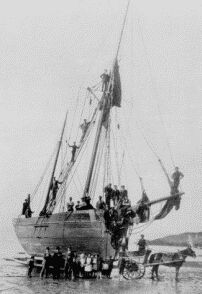
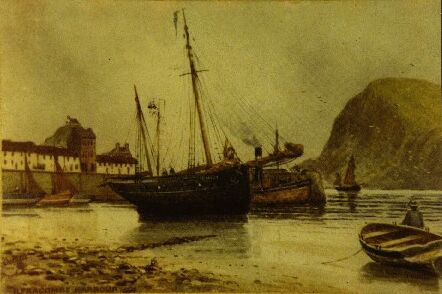 One of the first boats known to have delivered coal to Hele Beach was the
Emily, built in Jersey in 1869. This picture (right) shows her in Ilfracombe harbour c1890 when she was owned by Jack Irwin
of Ilfracombe. This well-known picture of the Emily delivering coal to Hele Beach (left) is usually dated to 1905, but if it is the same
Emily, then it is wrongly dated, since she is said to have been
wrecked off Clovelly in 1897. (2)
One of the first boats known to have delivered coal to Hele Beach was the
Emily, built in Jersey in 1869. This picture (right) shows her in Ilfracombe harbour c1890 when she was owned by Jack Irwin
of Ilfracombe. This well-known picture of the Emily delivering coal to Hele Beach (left) is usually dated to 1905, but if it is the same
Emily, then it is wrongly dated, since she is said to have been
wrecked off Clovelly in 1897. (2)
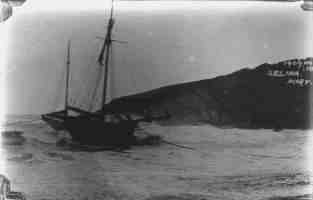 S
S imilar confusion surrounds another sailing ketch that used to deliver coal to Hele Beach, the Selina (or Salina) Mary. She was said to have been
wrecked off Rillage Point in 1906 or 1909, but is shown moored up in Hele Bay in
1909 (left) and in
Ilfracombe harbour (right) c1912. (3)
imilar confusion surrounds another sailing ketch that used to deliver coal to Hele Beach, the Selina (or Salina) Mary. She was said to have been
wrecked off Rillage Point in 1906 or 1909, but is shown moored up in Hele Bay in
1909 (left) and in
Ilfracombe harbour (right) c1912. (3)
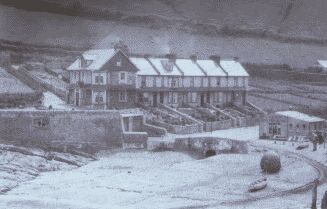 The boats came in at high tide, moored up, and had to be unloaded quickly at low
tide. Most of the coal was
The boats came in at high tide, moored up, and had to be unloaded quickly at low
tide. Most of the coal was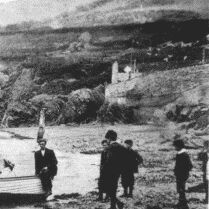 taken by horse and cart straight to the Gas
Works, but some was taken to the coal store beside the beach, opened by Thomas Upton in December 1905 for "good house coal, logs and lightings, at the lowest possible prices". This
photograph of the beach c1906 shows the coal store soon after it had been built
(left). A detail of another photograph of the beach, c1908, shows a small
office above the sea wall (right), which was used to manage the coal store.
The office has now gone, but the cave underneath is still there, as are the steps up from the beach.
Behind the fellow leaning on the boat is a large mooring post which can still be
seen on the beach. (4)
taken by horse and cart straight to the Gas
Works, but some was taken to the coal store beside the beach, opened by Thomas Upton in December 1905 for "good house coal, logs and lightings, at the lowest possible prices". This
photograph of the beach c1906 shows the coal store soon after it had been built
(left). A detail of another photograph of the beach, c1908, shows a small
office above the sea wall (right), which was used to manage the coal store.
The office has now gone, but the cave underneath is still there, as are the steps up from the beach.
Behind the fellow leaning on the boat is a large mooring post which can still be
seen on the beach. (4)
 There were three other mooring posts lower down the beach, all now gone (the base of
the main one can still be seen
There were three other mooring posts lower down the beach, all now gone (the base of
the main one can still be seen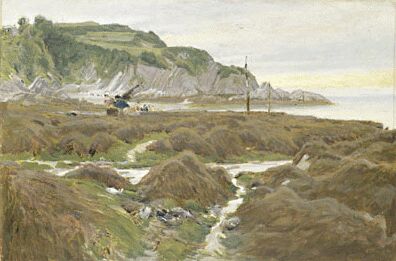 amongst the rocks).
A photograph of the early 1900's (left) and a painting by Albert Goodwin, who lived in Ilfracombe between
1876-1906 (right), show two of the lower posts. The third, just below Donkey Island,
may have been put there by J Irwin in
1913. There were several iron rings on the rocks either side of the bay
(there is still one, on the seaward end of an outcrop on the right of the beach).
When moored up, the boats must have looked like giant spiders! Before WW1, Hele beach was used so
regularly, that Charley Snow asked in 1914 that it be made a "harbour of refuge" (5).
amongst the rocks).
A photograph of the early 1900's (left) and a painting by Albert Goodwin, who lived in Ilfracombe between
1876-1906 (right), show two of the lower posts. The third, just below Donkey Island,
may have been put there by J Irwin in
1913. There were several iron rings on the rocks either side of the bay
(there is still one, on the seaward end of an outcrop on the right of the beach).
When moored up, the boats must have looked like giant spiders! Before WW1, Hele beach was used so
regularly, that Charley Snow asked in 1914 that it be made a "harbour of refuge" (5).
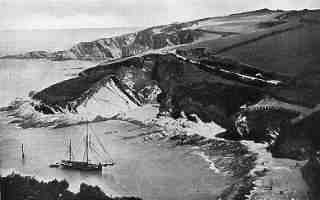 This photograph
(left) from c1927, of a sailing ketch
coming into Hele (possibly the Salina Mary?), shows
the main lower post; the post below
This photograph
(left) from c1927, of a sailing ketch
coming into Hele (possibly the Salina Mary?), shows
the main lower post; the post below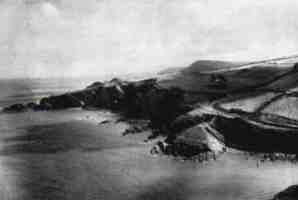 Donkey Island (behind the ketch's mast) and the post
on the beach. The area just above the cliffs, on the right hand side,
is fenced and no longer cultivated; possibly the first evidence of camping beside the beach.
The post below Donkey Island can be seen clearly in this photograph (below right) from c1936
and the posts are said to have still been in place after WW2.
Donkey Island (behind the ketch's mast) and the post
on the beach. The area just above the cliffs, on the right hand side,
is fenced and no longer cultivated; possibly the first evidence of camping beside the beach.
The post below Donkey Island can be seen clearly in this photograph (below right) from c1936
and the posts are said to have still been in place after WW2.
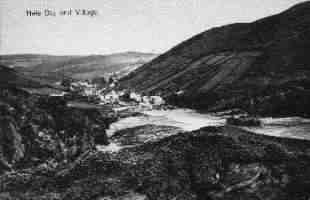 A familiar sight along the coast between Combe Martin and Ilfracombe,
was the Snowflake, a steam powered Clyde Puffer; a class of
boat constructed with a vertical boiler, to save on length, for navigating the
Scottish canals. She was built in Glasgow in 1893 as the Maid of Lorn and was registered as 73.3 tons with a
length of 66' (the maximum that could fit into the locks). She was wrecked off
Iona in 1896, repaired, and sold to flour merchants Hoskin, Trevithick
and Polkinhorne in Hayle, Cornwall, who renamed her Snowflake after their brand of flour.
She proved too small for their needs and was sold to the Irwin family of Combe
Martin in 1897. For the next 50 years she carried coal, building materials and
even fresh produce, i.e. Combe Martin strawberries, along and across the Bristol Channel. This picture (left)
is probably the Snowflake coming into Hele Bay in the 1920's.
She went ashore at Lester Point in 1912 and it is said that after a visit to Hele in the 1920’s,
when she was holed, she used Larkstone Beach for coal deliveries instead. She hit a rock off
Little Hangman in 1936 and was beached in Watermouth Cove (below right).
Her Captain then, James Irwin, is said to have remarked "I know
every rock in the Bristol Channel; and that was one of them". She was sold by the Irwin’s in 1940
but remained in the area, working as a water supply boat for the Armed Forces,
until she went to the Greek Islands in 1946. She was beached in 1953 in Piraeus
but was still registered, in the former Yugoslavia, in the 1960's. (6)
A familiar sight along the coast between Combe Martin and Ilfracombe,
was the Snowflake, a steam powered Clyde Puffer; a class of
boat constructed with a vertical boiler, to save on length, for navigating the
Scottish canals. She was built in Glasgow in 1893 as the Maid of Lorn and was registered as 73.3 tons with a
length of 66' (the maximum that could fit into the locks). She was wrecked off
Iona in 1896, repaired, and sold to flour merchants Hoskin, Trevithick
and Polkinhorne in Hayle, Cornwall, who renamed her Snowflake after their brand of flour.
She proved too small for their needs and was sold to the Irwin family of Combe
Martin in 1897. For the next 50 years she carried coal, building materials and
even fresh produce, i.e. Combe Martin strawberries, along and across the Bristol Channel. This picture (left)
is probably the Snowflake coming into Hele Bay in the 1920's.
She went ashore at Lester Point in 1912 and it is said that after a visit to Hele in the 1920’s,
when she was holed, she used Larkstone Beach for coal deliveries instead. She hit a rock off
Little Hangman in 1936 and was beached in Watermouth Cove (below right).
Her Captain then, James Irwin, is said to have remarked "I know
every rock in the Bristol Channel; and that was one of them". She was sold by the Irwin’s in 1940
but remained in the area, working as a water supply boat for the Armed Forces,
until she went to the Greek Islands in 1946. She was beached in 1953 in Piraeus
but was still registered, in the former Yugoslavia, in the 1960's. (6)
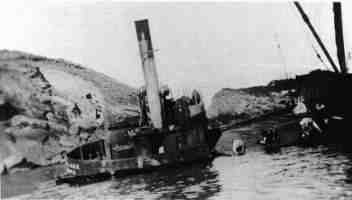
There is no evidence that the coal store by the beach was used after 1906, when it was mortgaged by Thomas Upton. It certainly wasn't needed by the Gas Company, who had their own storage facility. The little coal office later became a greenhouse and was demolished early in the 1960's. Coal deliveries to Hele for the Gas works probably continued until the 1930's and may have continued up until WW2. After that, coal was delivered to Larkstone Beach instead and taken to the works by lorry. For example, in 1953, 23,000 tons of coal were discharged at Ilfracombe for use in the gas works. Coal deliveries ceased in 1962 when the Gas Works stopped producing gas. (7)
(1) Small boats could pass up to the mill ?
"Coal and other goods used to be delivered by ship to Hele beach, so it is likely that millstones also came by ships. There is even a legend that small boats could float right up to the mill" (Guide to Hele Mill, p 1, pamphlet from Hele Mill, probably written by Chris Lovell, Copyright Hele Mill 1994)
(2) Emily
Colour-tinted photograph of Emily in Ilfracombe harbour, says c1890 on the back (ILFCM 25173G)
The photograph of the Emily on Hele Beach, May 1905, is in Ilfracombe Museum with the caption "A ketch unloading coal: Emily built in Jersey. Owned by Capt. Jack Irwin" (IM ????) A copy is in Hele Mill with the caption "A ketch unloading coal on Hele beach. She was built at Jersey and owned by Captain Jack Irwin. Given by Geo. Williams of Britannia Row"; Another copy has the following written underneath "[????] May 1905 - the Ketch Emily has come to Hele Beach near Ilfracombe with the [week?’s] Supply of coal for Berrynarbor. Discharge is complete and the gang of men [that?..] have unloaded her, the farm cart with the last load, and a huddle of children [pose?..] for the photographer. The Emily was built in Jersey in 1861 and when this picture was taken she was owned by Captain Jack Irwin of Chambercombe" (C Hancock); Another copy has the caption "In the days when West Country sailing ketches delivered cargoes of many kinds around the coast, they were frequently beached to be unloaded into horse-drawn carts. Here coal is being delivered at Hele, less than a mile east of Ilfracombe" (Lamplugh 1996 p99); Another copy, shown above, has the caption "May 1905 the ketch Emily at Hele Beach after unloading coal, she was built by Picot of Jersey in 1869" (from an article about Robert Stephen Hawker, Morwenstow poet & antiquary 1803-1875, from website http://msn.homepages.talkcity.com/ProjectPl/jerseyseals/index.htm [no longer exists 2006])
"Emily. Owned by J Irwin, Chambercombe & John Martin Combe Martin. Built at Jersey in 1869. Registered Jersey. Net tonnage 40. Lost off Clovelly in 1897" (handwritten notes in Ships box, Ilfracombe Museum)
(3) Selina Mary
"Up to 1909 the boat "Selina Mary" brought coal to Hele beach, and then taken by horse and cart up the stream, but after the boat was wrecked of Rillage Point the coal was brought to Ilfracombe in the Snowflake (so called because she was originally used for carrying flour) then delivered to the gas works by lorry. Many men found employment in the Gas Works - and when the hooter went for the dinner-break, all the housewives with washing on their lines would rush to fetch it in because otherwise it would be speckled with black, which came out with the steam from the hooter" (ICTG 1985-6 p 4,5)
Coal was brought in to Hele by the Salina Mary and unloaded by horse and cart until 1906, when she was shipwrecked (Campbell 1986)
Photo of Selina Mary moored at Hele, taken 1909, shown above, has "1909 No.10 Selina Mary" on the picture and hand-written underneath "Selina Mary, Captain John Irwin" (C Hancock). This is either a different Selina Mary (the spelling is different) or she didn't sink in 1906!
Photo of Salina Mary in Ilfracombe Harbour c1912, shown above. If the date and attribution are correct, then she wasn't wrecked in 1906 or 1909 ! (ILFCM 25173G says c1912 on the back)
(4) Coal Store & Office
"New Coal Business, T Upton, begs to inform the inhabitants of Ilfracombe and neighbourhood that he has opened a COAL STORE AT HELE and is prepared to supply good house coal, logs and lightings at the lowest possible prices. Offices: the Quay Ilfracombe & Hele Beach" (Ilfracombe Chronicle Dec 23rd 1905 p 4 col 6/7)
A J Valentine/Valentines postcard of Hele Beach c1906, used above, shows the coal store soon after it had been built. From Bartlett 1987 p 47, reproduced by kind permission of the Tom Bartlett Archive Postcard Collection, Berrynarbor, Devon EX34 9SE.
A postcard of a small boat on Hele Beach, c1908, of which a detail is shown above (Bartlett 1995 p79, postcard by E Osborne, Ilfracombe, postmark 1909 so probably 1908 or before, reproduced by kind permission of the Tom Bartlett Archive Postcard Collection, Berrynarbor Devon EX34 9SE) shows a building above the sea wall (where the 'cave' is now) with a chimney, a diamond shaped sign, and a telephone pole & wire. Most likely this was built as an office for the coal store and/or the builders store. The mooring post at the top of the beach is also shown.
(5) Mooring Posts
The main lower mooring post is marked on the 1891 Ordnance Survey of Hele.
The photograph of two lower posts, shown above, was taken c1901-1910 (ILFCM 9618 says 1901-10 on the back)
June 1913 - "Captain J Irwin complained that he had been ordered to discharge his vessel at an unsafe berth in Ilfracombe harbour. He asked for a safe berth when it was not possible to put in at Hele. It was argued that he was always free to unload on the beach but that unloading on the Quay would be allowed except from Easter to October" (IC June 7 1913 p 6 c 3)
September 1913 - "Mr J Irwin asked to fix a mooring post on rock at Hele Beach. He had previously asked in 1909 but at that time permission was refused because he wanted to blast a rock. Agreed." (Ilfracombe Chronicle Sept 6th 1913 p 6 c 5). If the two posts low down the beach were already there before 1910, then this was most likely the third post, near the top of the beach (the only one still there)
This painting by Albert Goodwin (date unknown), shown above (used by kind permission of Chris Beetles Gallery www.chrisbeetles.com), of Kelp gatherers on Hele Beach, also shows the lower two mooring posts. The house to the left has probably been added for artistic licence (or represents Mr Lewis' fernery).
Albert Goodwin moved to Ilfracombe in the latter half of 1876 to 7 Montpelier terrace. He started a diary in 1883. He moved to Bexhill-on-Sea, Sussex in 1906 (John Woodcock, The Illustrated Diary of Albert Goodwin 1845-1932, published after 1997, Ilfracombe Museum)
January 31st 1914 - "Mr C H Snow (Charley) wrote to Miss Clarke to ask her to move that Hele beach be made a harbour of refuge (for unloading coal). He is happy to pay harbour fees as that will be less than it costs him already" (IC Jan 31st 1914 p 6 c 4)
The photo of a sailing ketch coming into Hele Bay is the first picture of Hele in an Ilfracombe Guide. It is shown in the Ilfracombe Guide of 1928, so must be from 1927 or before. It is probably after the golf pavilion extension of 1924. The picture above is from Ilfracombe Museum, which is a better copy (ILFCM21170B). It shows an unknown sailing boat (looks very similar to Emily or Selina Mary); the building above the cave on the beach; all three mooring posts on the beach; and a fenced area at end of the cliffs, now part of the Holiday Park. There seems to be a horse and cart going up Watermouth Road, before it was widened.
Another picture of Hele Bay shown in the 1937? Ilfracombe Guide (date uncertain) shows the mooring post nearest to Donkey Island. The copy shown above is from the 1939 Ilfracombe Guide, which is a better copy. It was taken after Watermouth road was widened c1932 and after the Coastguard Cottages were built c1933, so a 1936 date (for 1937 guide) is probably correct.
(6) Snowflake
"Mr James Irwin, of the Dolphin Inn who was in a voyage on the Snowflake to Newport was the victim of an accident whilst there. He was proceeding on board the vessel across a plank and slipped falling a distance of 14’ into the bed of the river with the result that his knee was very much injured" (Ilfracombe Chronicle Jan 21st 1905 p 5 col 3)
The postcard of a boat in Hele Bay, shown above, from Ilfracombe Museum (ILFCM 25203, says on it "Hele Bay and Village 1380 Ilfracombe Chronicle series") was probably taken after c1924 when a second storey was added to Lewis' but before the promenade was built c1934. The boat is probably the ‘Snowflake’ (not a sailing craft)
"NEARLY DROWNED Clergyman Saved by Ilfracombe Men TIMELY RESCUE NEAR PORLOCK Capt. Irwin and crew of SS Snowflake, of Ilfracombe, effected a timely rescue of a Porlock clergyman from drowning in Porlock Bay on Saturday. The steamer was returning from Lydney when about 1 1/2 miles north-east of Hurlston Point Capt. Irwin heard cries for help, and saw a swimmer on the point of drowning about a mile from Porlock shore. The man had swum out and was making an effort to return, but he failed to overcome the very strong tide. Captain Irwin immediately altered the ship's course and came alongside the man, who was got on board. He at once collapsed. Later he was transferred to a Porlock motor vessel and taken ashore. The swimmer was Rev. H Smith, on holiday relief at Porlock. He had been swimming out and had been carried away by the tide. In an interview, Capt Irwin said: "We rescued the unfortunate man just in the nick of time. When we saw him he was in a most dangerous part of the channel; only a few months ago two soldiers who were camping in the district lost their lives by drowning in exactly the same spot. When our men got him aboard he was absolutely exhausted. The promptitude of our men was wonderful." Coastguards from Porlock had seen Mr Smith in difficulties and had sent other help. A fellow-swimmer from Porlock had tried to reach him, but was forced to give up owing to the strong tide. Mr Smith was little the worse for his adventure, and was able to preach at both services on Sunday" (Ilfracombe Chronicle July 15 1934)
The photo, shown above, of the Snowflake aground in Watermouth Cove, was taken in August 1936 (Archive Quarterly Journal British Industrial and transport History, Issue 7 Lightmoor Press, Witney, Oxfordshire Sept 1995) and has the caption "On 23/8/1936 at 2.45am the Snowflake ran aground in Watermouth Cove and was refloated and towed to Ilfracombe harbour two days later".
"Never was a more tubby, grubby, quaint and comic little ship. She is about 60’ long, slab-sided, with bow and stern, alike rounded, sitting down well aft. A tall mast, an enormous smokestack, a pile of superstructure, which after all is only meant to house the master at the wheel, and you have the Snowflake. Before 1914 she was ‘The Strawberry boat’, when every summer she used to run hard quick passages to Swansea to carry vast quantities of the world’s most delicious berries to the market....A famous trio of brothers, the Irwin's, owned and sailed the Snowflake...Says Cap’t Irwin at sea one day ‘I know every rock in the Bristol channel’; and then, as the Snowflake struck and bounced off -’That’s one of them’" (Boyle & Payne 1952 p 215-6)
"The long-lived Snowflake, built of steel on the Clyde in 1893 - a genuine Clyde Puffer in fact, is well remembered today by some of the older generation" was named by the Vicar of St Philip & St James, her skipper James Irwin was nicknamed ‘Tulip’" (North Devon Journal Jan 1928)
NDJ article Oct 2nd 1947 of the golden wedding anniversary of George Hicks who had been master of the Snowflake. There is a picture of him and his wife.
"SS Snowflake. Owned by Captain James Irwin, Combe Martin. Built on the Clyde. Launched as the Maid of Lorn, renamed Snowflake when Capt. Irwin bought her in 1897. She was a puffer, which were class of small cargo steamers built on compact lines to take up as little space as possible in the locks of the Scottish canals. They were fitted with upright boilers, to save a few feet in length and the helmsman stood on top of the boiler to steer with a canvas dodger in front of him. In 1940 the Snowflake was sold to AJ Smiths of Bristol who chartered her to the Government as a water supply vessel. Based at various times at Milford Haven, Portsmouth, Weymouth and Salcombe. She took water to ships and isolated riverside camps where British and allied troops were massing for the invasion of Europe. Then in 1946 with her war service ended, she returned to Bristol and a few months later was sold to Greek owners to trade in the Greek Islands under the Panamanian flag. In 1953 there came news she had been in collision at Pireus, but it is not known whether she was repaired or not." (Handwritten notes in ships box, Ilfracombe Museum)
"SS Snowflake 1897 to 1953. Owned by Captain James Irwin, Combe Martin, who bought her in 1897. She was built on the Clyde and launched as the Maid of Lorn. Capt. J Irwin renamed her Snowflake. Her class was a Clyde puffer, a class of small cargo steamers, built on compact lines to take up so little space as possible in the locks of the Scottish canals. They had upright boilers to save a few feet in length and the helmsman stood on top of the boiler as the wheel was fitted there, there was no wheel house only a 'canvas dodger' to protect the helmsman. Many a time she has come around Rillage Point and Beacon Point with only the mast head visible, the rest of her hidden under the waves. She carried a crew of four - Captain, mate, crewman and engineer. For years before 1940 her skipper was Jimmy (Tulip) Irwin; Mate Bobby Rigger (real name Robert Rickard; Crewman Jimmy Rees; Engineer Ray Irwin; Cook Bill Green. I knew over the years. In 1940 she was sold to AJ Smiths, Queens Square, Bristol and was chartered by the Government as a water supply vessel. Based at Milford haven, Portsmouth, Weymouth and Salcombe. She took fresh water to ships and isolated riverside camps, where the British troops and Allied troops were massing for the invasion of Europe. Then in 1946, her war service over, she returned to Bristol, and a few months later was sold to Greek owners to trade in the Greek Islands, under the flag of Panama. In 1953 there came news she had been in collision off Piraeus and beached but it is not known whether she was ever repaired or not" (Handwritten notes in ships box, Ilfracombe Museum)
By 1934 the Snowflake was in the managing ownership of John Irwin, Combe Martin. Her cargo was usually coal but in the 30’s at least, she underwent a remarkable transformation each summer. Her blackened hold was washed clean and painted white, she carried thousands of baskets of strawberries, grown on the warn slopes above Combe Martin, to markets in south Wales - and no doubt brought some to Ilfracombe (Lamplugh 1984)
"The Snowflake was built in 1893 at Glasgow as a 'Clyde puffer', was 73 tons register and 66ft long. First named Maid of Lorne she was sold to flour merchants at Hayle who renamed her after their brand of flour. In 1897 she was bought by the Irwin family of Combe Martin and spent the next 43 years up and down the Bristol Channel, earning a special place in the affections of Combe Martin people. She brought coal for Ilfracombe Gas Co., materials for builders merchants and full general cargoes to Combe Martin, returning, in season, with strawberries and early potatoes to Swansea. She was sunk once on the Clyde and in 1936 struck a rock off Little hangman but made it back to Watermouth where she was beached. At some stage she rescued a Parson who had been swept out to sea from Porlock" (CMLHG 1994 p 1) caption to photograph of Snowflake entering Combe Martin.
"It is perhaps a little ironic that, of all the vessels which traded in and out of Combe Martin bay, the many smacks and ketches, sleek of line and often Devon-built, the best remembered is a stubby little coastal steamer that hailed from hundreds of miles away, on the Clyde. For forty-three years, the Snowflake plied her trade around the Bristol Channel, only occasionally venturing further afield, and in the process wormed her way into the affections of two generations of maritime folk along the North Devon coast. Owned in Combe Martin and registered in Barnstaple, she took strawberries and early potatoes to South Wales, brought back coal for Ilfracombe gas works and Alfred Oxenham, the Lynmouth coal merchant, and delivered builder's supplies and general provisions back to her home village. Snowflake was a 'Clyde Puffer', a redoubtable breed of steamer built for use on the Forth and Clyde canal (the length of the locks on this waterway dictated the 66 foot length of the vessels) and around the Scottish coasts and islands,. She was built in 1893 at Hamilton Hill. Glasgow, by Burre & Son and launched as the Maid of Lorn. She was 73.3 tons, 66 feet long, 18 feet 3 inches breadth, smack rigged and built of steel. Her number was 99880 and her signal letters were MQYC. Her 2-cylinder compound engines were provided by Walker, Henderson & Co. of Glasgow and were capable of producing 20 NHP. She was owned on the 64th share system, the most important of her owners being, John Muir Paton, who built up a large fleet of puffers and later coasters, in partnership with P. D. Hendry. Maid of Lorn was wrecked on 17th April 1896 at the north east point of Eilean Ura on Iona, whilst on a voyage from Scarnish, Tyree, to Colila, Islay, in ballast. She was recorded as lying in a 'bad position' but, nevertheless, was recovered and reregistered at Glasgow in the name of George Webster. It is likely that the vessel had been abandoned to the underwriters as a constructive total loss and, after salvage, sold by them to Webster. He quickly sold the puffer on down to Cornwall, to the Hayle flour merchants Hoskin, Trevithick and Polkinhorne (this Trevithick was John Harvey, son of Richard). They registered her at Penzance and renamed her Snowflake. after their premium brand of flour, but quickly found the vessel too small for their needs. They replaced her with the steamer M. J. Hedley and in 1897 Snowflake was sold to the Irwin family of Combe Martin. the principal ship-owners in the village. Various members of the family sailed in her over the years, including John Irwin, her last master and always known as 'Cap'n Jack'. Snowflake continued to lead an eventful life. She went ashore at Lester Point in 1912 and, at some stage in her career, rescued a young parson swept out to sea when bathing off the rocks at Porlock. In 1936 she was beached at Watermouth after striking a rock outside Combe Martin bay. After repair, Snowflake carried on trading out of Combe Martin until 1940, when wartime restrictions in the Bristol Channel curtailed her activities. On the 17th December 1940, she was purchased by Alfred J. Smith Ltd. of Bristol, who promptly chartered her out to the Government for use as a water carrier. Snowflake was variously based at Milford Haven, Portsmouth, Weymouth and Salcombe, taking water to ships and isolated riverside camps where troops were assembling for 'D' Day. In 1946 she returned to Bristol and was sold to trade amongst the Greek Islands. She is reputed to have run illegal immigrants into Palestine in the late 1940s and was involved in a collision in Piraeus harbour in 1953. Whilst being repaired, the opportunity was taken to lengthen her and she was last heard of registered at Split, Yugoslavia. in the 1960's leaving us with the enticing possibility that she may still survive out there somewhere" (Archive, the quarterly journal for British Industrial and Transport History, Lightmoor Press, issue 7 1995 p 15)
"The Snowflake, for many years a familiar sight in Ilfracombe harbour. She was a Clyde Puffer, built in 1893. The Irwin family of Combe Martin bought her in 1898, and sailed her for 43 years. She carried coal and general cargo in the winter, but in summer, her hold washed and painted white, she carried strawberries and early potatoes to Swansea and other places" (Lamplugh 1996 p 105) Caption to a picture of the Snowflake in Ilfracombe harbour, not copied.
"The little steamer Snowflake has been a familiar feature of the Bristol Channel for nearly sixty years. She is still afloat and was in Appledore Dock about 1948. In the years about 1912 she was constantly employed taking soft fruit from Combe Martin to South Wales, where jam factories used it. 1 have often seen her in Ilfracombe. Two men and a boy comprise her ship's company. The Captain is James Irwin and his brother Ray is the Engineer. The boy is the foremast hand. The two Irwins have owned and run the Snowflake for the best parts of their lives. My brother Jack Boyle went across from Combe Martin to Swansea in about 1911 and I well remember that one of the stories the engineer and Captain told him then was how he had once gone down with a vessel which had sunk suddenly and had nearly been drowned as he was below at the time. He said he struggled up, swam towards the surface and then found himself wedged between the shrouds and the mast, up where they were close together near the hounds. Nevertheless, he got clear and was picked up." (The Devon on disk project, August 2000, photocopy of notes in Ships box, Ilfracombe Museum)
"Capt. J R. Pile gives the following stories: Captain Irwin was always a great one of getting in around the coast, dodging the tide when it was contrary. In under Hangman, or between Morte Stone and Morte Point, and of course between Baggy Point and Baggy Leap. Coasters reckoned he had struck every rock in the Channel in the course of these exploits. On one occasion a sea lifted the Snowflake and dropped her stern down on to a rock over which the Captain had no doubt often sailed on calmer days. On this occasion the little ship had a propeller blade curled up and the tail of the shaft bent upwards insomuch that it could not turn. The Snowflake had to be towed to Appledore then. As I have said, Captain Irwin was a great one for threading in around the shoals and rocks of the Bristol Channel. Once when he had a friend beside him on the bridge of the Snowflake at sea he said, "I know every rock in the Channel." At that moment the Snowflake ran smack on a rock. "That's one of 'em," he said. His nickname was "Tuttery", because he stuttered. Probably in calm moments he could say "Stop her!" or "Full astern!" without trouble, but once when coming in to Lydney Pier a little eddy or a twist of current began to take the ship bow on to the pier. The Captain applied his mouth to the speaking tube which led to his brother in the engine room, say ten feet way. "S - S - S - S" he stuttered, but couldn't get out the all-important "Stop her!" The Snowflake collided with the pier full-butt. The poor engineer was thrown violently on to his heap of coal and the Snowflake's bow got a great dent which she bears to this day. At that the Captain's tongue loosened and down through the skylight he said to his prostrate brother, "Bump-oh, you b .......!" VC Boyle, February 1950; Addendum from VC Boyle, 1951: Pilot William Stribling says that the Snowflake never came to Barnstaple without a pilot., nor did the Devonia. The pilotage of the Taw is a far riskier matter than that to Bideford. There is far less water up to Barnstaple, the "Gut" is narrower, in a bigger expanse of tidal water (the Taw is wider than the Torridge), and the lower Taw winds more. The Gut winds in parts where the banks (hwmk) show no sign of winding. For a vessel to get stranded in the Taw seems to be very dangerous. Witness the loss of the Fleetwing, related elsewhere. The papers of Mr V C Boyle are held at the North Devon Maritime Museum at Appledore. Grateful thanks to the staff there for making the above available to the 'North Devon on Disk' project." (The Devon on disk project, August 2000, photocopy of notes in Ships box, Ilfracombe Museum)
"Sincere thanks also to Ilfracombe Museum who have forwarded the following account: S. S. Snowflake 1897 to 1953 Owned by Captain James Irwin, Combe Martin, who bought her in 1897. She was built on the Clyde and launched as the "Maid of Lorn ". Captain James Irwin renamed her "Snowflake". Her class was a "Clyde Puffer ", a class of small cargo steamers built on compact lines to take up so little space as possible in the locks of the Scottish canal. They had upright boilers to save a few feet in length and the helmsman stood on top of the boiler as the wheel was fitted. There was no wheel house, only a "canvas dodger" to protect the helmsman. Many a time she come around Rillage Point and Beacon Point with only the mast head visible, the rest of her nearly under the waves. She carried a crew of four - Captain, Mate, Crewman and Engineer. For years before 1940 her skipper was Jimmy (Tulip) Irwin, Mate (Bobby Rigger, real name Robert Rickard), Crewman Jimmy Rees, Engineer Ray Irwin. Also Bill Green, the Cook, I knew over the years. In 1940 she was sold to A. J. Smiths, Queens Square, Bristol and was chartered by the Government as a water supply vessel. Based at various times at Milford Haven, Portsmouth, Weymouth and Salcombe. She took fresh water to ships and isolated riverside camps where the British troops and Allied troops were massing for the invasion of Europe. Then, in 1946, her war service over, she returned to Bristol and a few months after was sold to Greek owners to trade in the Greek Islands under the flag of Panama. In 1953 there came news she had been in collision off Piraeus and beached. But it is not known whether she was ever repaired or not." (The Devon on disk project, August 2000, photocopy of notes in Ships box, Ilfracombe Museum)
(7) Larkstone
June 18 1953 "23,000 tons of coal is to be discharged at Ilfracombe for use in the town's gas works (North Devon Journal June 19th 2003, "50 years ago")